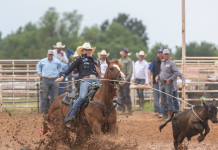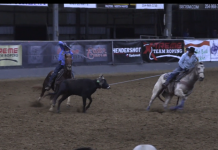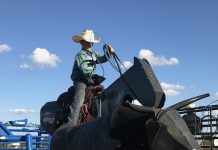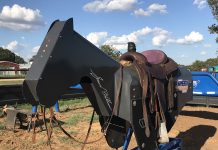Leaving your sweet spot to become a better roper
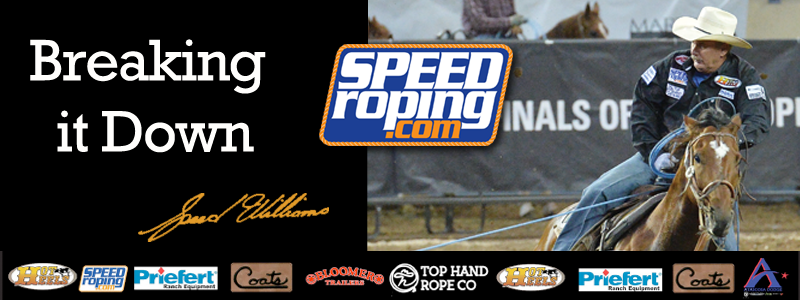
While we were at the Texas Junior High finals in Gonzales I had some match ropings for girls and boys on the Speed Trainers. In the breakaway match the girls were really reaching to the end of their rope at 18 feet and the boys were reaching up to 24 feet. A lot of kids did pretty good. But, when I put money up for the close drill where you have to have weight in your stirrups, butt out of the saddle, not pulling bridle reins (and lighting up the Speed Trainer), then take two swings, rope and dally under 2.5 seconds it was a different story. I had over 40 kids go and didn’t have two qualified times. There were a few that I had given lessons to that could do it.
Afterwards we talked about it. When you spend all that time roping the dummy at 10 to 12 feet with a one coil reach, and don’t work on other options and scenarios, then you are very limited. That’s one of the things the Speed Trainer built for, to find holes in my kids and clients roping. I can set it up at all different angles and positions. For every possible loop you will ever have to throw at a steer, I can create that scenario. I’ve had #4 headers that when roping the dummy within an 18” circle looked like a #7. But if the dummy moved closer or further out of that window, they couldn’t catch at all. It would be like learning to play golf and only using one club.
Team ropers struggle to get in the same position. When roping the dummy on the ground, they rope from the same position over and over, called their sweet spot. Once you’re in the middle of a run it’s very difficult to get in that same sweet spot every time. Especially now with so many ropings using the World Series barrier where you have a long box and short start. You have to learn to rope the steers close because the slow cow is the one you want to draw. There were so many young kids that couldn’t catch the good cow. But they could reach 20’ on the dummy and look outstanding. That doesn’t apply just to the youngsters. I have clients who are #6 and #7 headers that don’t work on their short game.
Understanding your weakness and being willing to work at that, and not just rope in your comfort zone, is essential if you’re going to improve. Professional header, and NFR qualifier, Dustin Egusquiza lives about 30 minutes from me and has been coming over regularly for the last couple of months. His “go fast” is quite amazing. Jake Long’s “go fast” is quite amazing. But their jackpotting was lacking. We’ve talked a lot about living on the edge and doing things with a very small error margin on every run. What’s fun about working with those guys is when you give them something to try, they are able to change and implement it very quickly.
I have some slow steers with big horns and Dustin runs them every time he comes because in the beginning he really struggled with them. A couple of days ago when we watched the video and he had roped them all, he said he had “mastered the big horns” that day. That was him working on things he doesn’t do well. When he would run close he would have way too much rope between him and the cow. So, we had to shorten his loop and spoke, then he learned to slide his left hand forward to take up slack, before pulling his slack. Doing this he can get his rope tight before going left. He had never worked much on roping close because his reaching is so good.
A lot of the guys from back east, Kaleb, Dustin, and myself, we were all reachers to begin with but then you have to evolve and learn the rest of the game. Every day that Dustin comes over he gets on the Speed Trainer and does close up drills and then pushes it out as far as he can throw it. His riding has come a long way.
What’s new with me: I’m very happy with my kids’ roping and the drills their doing on the Speed Trainer. They’ve both improved dramatically especially Hali with her breakaway and Gabe with his heeling. For more information on the Speed Trainer, visit speedroping.com and check out the videos to see how it can help your roping. One of my favorite benefits is how much it improves horsemanship and riding. It keeps you from pulling on the bridle all the time. This helps your horse not run through the bridle. It’s frustrating for people to change bits constantly trying to find something to control their horse, when usually it’s pilot error.


